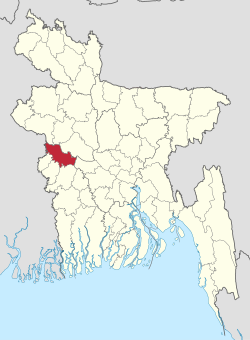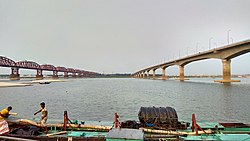Kushtia District
Kushtia district
কুষ্টিয়া | |
|---|---|
From top, left to right: Hardinge Bridge and Lalon Shah Bridge over the Padma, Shilaidaha, Tomb of Lalon, Fields in Bharamara | |
 Location of Kushtia District in Bangladesh | |
 Expandable map of Kushtia District | |
| Coordinates: 23°55′11″N 89°13′12″E / 23.91985556°N 89.220030556°E | |
| Country | |
| Division | Khulna |
| Headquarters | Kushtia |
| Government | |
| • Deputy Commissioner | Md. Ehtesham Reza [1] |
| • District Council Chairman | Rabiul Islam [2] |
| • Chief Executive Officer | Md. Joynul Abedin [2] |
| Area | |
| • Total | 1,608.78 km2 (621.15 sq mi) |
| Population | |
| • Total | 2,149,692 |
| • Density | 1,300/km2 (3,500/sq mi) |
| Time zone | UTC+06:00 (BST) |
| Postal code | 7000 |
| Area code | 071 |
| ISO 3166 code | BD-30 |
| HDI (2019) | 0.644[4] medium · 5th of 20 |
| Website | www |
Kushtia District (Bengali: কুষ্টিয়া জেলা, pronunciation: kuʃʈia) is a district in the Khulna administrative division of western Bangladesh. Kushtia is the second largest municipality in Bangladesh and the eleventh largest city in the country. Kushtia has existed as a separate district since the partition of India.[5] Prior to that, Kushtia was name of a subdivision of Nadia district. Kushtia is the birthplace of many historical figures including Mir Mosharraf Hossain (1847–1912),[6] Bagha Jatin (1879–1915)[7] and Lalon (1774–1890).[8] Nobel laureate poet Rabindranath Tagore lived his early life at Shelaidaha, a village in the district.[9]
History
[edit]In 1860, the Indigo revolt spread throughout the Bengal province. Shalghar Madhua in Kushtia district was one of the forerunners in this movement.[5] It inspired all indigo farmers in Kushtia to refrain from paying government taxes.[5] Subsequently, with the publication of the Indigo Commission Report, an act was passed prohibiting coercion of cultivators for indigo cultivation and the measure led to the end of the movement.[10]
During the Partition of India in 1947, three sub-divisions of Nadia district i.e. Kushtia, Chuadanga and Meherpur were made into a new district of Kushtia in the then East Pakistan. The town once again became attractive for development in 1954 with the establishment of the Ganges-Kobadak Irrigation Project (also known as G-K Project) headquarters and a number of government offices. The G-K Project is a large surface-irrigation system, with the first crop under this project grown in 1962–63.[11]
The district of Kushtia had significant contribution to the Bangladesh Liberation War. A 147-member company of the 27th Baloch Regiment of the Pakistan Army reached Kushtia on 25 March 1971 from its base at Jessore cantonment. They initially captured the local police station and settled an outpost there, but soon faced considerable resistance from a group of police, ansars, students and local people. By 1 April, the Pakistani army was completely overpowered and the Mukti Bahini took control of Kushtia and emerged victorious in the Battle.[12] Later on 17 April 1971 the Bangladesh Government in-exile formally announced Proclamation of Independence at Baidyanathtala.[13] Subsequently, battles between the Pakistan Army and the rebels occurred at many places of the district including Bangshitala of Kumarkhali Upazila,[14] and Daulatpur Upazila.,[15]
After the independence of Bangladesh several different development projects were undertaken in the district of Kushtia. On 22 November 1979 the foundation stone of The Islamic University was laid at Shantidanga – Dulalpur under the districts of Kushtia and Jhenidah. However, In 1982 the university was shifted to Gazipur and admission of students began in the session of 1985–86. Later, on 10 January 1990, the university shifted back to its original site at Shantidanga Dulalpur. In 1984, two subdivisions of Kushtia, Chuadanga and Meherpur, were named separate districts.[16][17]
Geography
[edit]Kushtia District has an area of 1608.80 square kilometres and is bounded by Rajshahi, Natore, Pabna districts to the North, by Chuadanga, Jhenaidah districts to the South, by Rajbari District to the East, and by West Bengal and Meherpur District to the West.
Ganges, Gôŗai-Modhumoti, Mathabhanga, Kaligônga, and Kumar are the main rivers flowing through the district. The average high temperature is 37.8 °C and the average low is 9.2 °C. Annual rainfall averages 1,467 millimetres.
Administrative divisions
[edit]Kushtia district is divided into 6 upazilas, 7 police stations, 5 municipalities, 67 union councils, 710 mauzas and 979 villages.[18]
| No. | Upazila | Area (sq km) | Population (people) Census-2022 | Constituency | Union |
|---|---|---|---|---|---|
| 01 | Kushtia Sadar Upazila | 316.26 | 5,60,952 | Kushtia-3 | 14 |
| 02 | Kumarkhali Upazila | 258.38 | 3,73,734 | Kushtia-4 | 11 |
| 03 | Khoksa Upazila | 115.60 | 1,43,827 | 09 | |
| 04 | Mirpur Upazila | 296.31 | 3,63,080 | Kushtia-2 | 13 |
| 05 | Bheramara Upazila | 153.72 | 2,25,041 | 06 | |
| 06 | Daulatpur Upazila, Kushtia | 461 | 4,82,965 | Kushtia-1 | 14 |
Demographics
[edit]| Year | Pop. | ±% p.a. |
|---|---|---|
| 1974 | 1,022,781 | — |
| 1981 | 1,236,135 | +2.74% |
| 1991 | 1,502,126 | +1.97% |
| 2001 | 1,740,155 | +1.48% |
| 2011 | 1,946,868 | +1.13% |
| 2022 | 2,149,692 | +0.91% |
| Sources:[3][19] | ||
According to the 2022 Census of Bangladesh, Kushtia District had 565,339 households and a population of 2,149,692 with an average 3.77 people per household. Among the population, 363,166 (16.89%) inhabitants were under 10 years of age. The population density was 1336 people per km2. Kushtia District had a literacy rate (age 7 and over) of 69.01%, compared to the national average of 74.80%, and a sex ratio of 1036 females per 1000 males. Approximately, 21.26% of the population lived in urban areas. The ethnic population was 2,117.[3]
| Religion | Population (1941)[20]: 84–85 | Percentage (1941) | Population (2022)[3] | Percentage (2022) |
|---|---|---|---|---|
| Islam |
381,261 | 73.48% | 2,090,622 | 97.25% |
| Hinduism |
137,422 | 26.49% | 58,771 | 2.73% |
| Others [b] | 178 | 0.03% | 299 | 0.02% |
| Total Population | 518,861 | 100% | 2,149,692 | 100% |
In 2011, Muslims formed 97.02% of the population, Hindus 2.92%, and others 0.06%. The absolute number of Hindus has fallen continuously from 1981 to present-day.[19]
In 2001, Kushtia District had a population of 1,740,155, of which 50.86% are male and 49.14% female. In terms of religion, 96.67% dwellers of Kushtia were Muslims, 3.29% follow Hinduism and other religions make up 0.04%. Religious institutions are mosques 3587, temples 300, churches 256.[5]
Tourism
[edit]The Shilaidaha Rabindra Kuthibari is an ancestral mansion of the erstwhile Tagore Zamindari.The Kuthibari, located at Shilaidaha in Kumarkhali Upazila of the Kushtia district, is only 20 km from Kushtia town. Rabindaranath Tagore lived here for part of his life, and wrote many memorable poems there. The Kuthibari is now a museum, and is cared for by the Archaeological Department of Bangladesh.
The shrine of Lalon Fakir, the founder of the Baul order is located at Cheouria, about 2 km from the Kushtia railway station. You will have Famous Tiler Khaja Factory at just beside the Milpara Rail Gate in Kushtia Town.[21]
Media
[edit]Numerous Bengali daily and weekly newspapers are published from Kushtia. There is also a Bengali TV channel broadcast in the region.
- KUSHTIATOWN.COM
- DOINIK24
- Amader Zone 24
Notable people
[edit]- Lalon, mystic poet, philosopher, social reformer
- Bagha Jatin, revolutionary and martyr
- Surendranath Dasgupta, Sanskrit scholar
- Radhabinod Pal, Indian judge
- Kangal Harinath, journalist, writer, poet and Baul singer
- Qazi Motahar Hossain, writer, scientist, statistician, chess player, and journalist
* Sultana Firdousi, writer and poet[22]
See also
[edit]References
[edit]- ^ pmis.mopa.gov.bd/pmis/Forms/dclist.php
- ^ a b zp.kushtia.gov.bd
- ^ a b c d e Population and Housing Census 2022 National Report (PDF). Vol. 1. Bangladesh Bureau of Statistics. November 2023.
- ^ "Sub-national HDI - Area Database - Global Data Lab". hdi.globaldatalab.org. Retrieved 18 March 2020.
- ^ a b c d Nehal, SM Rakib (2012). "Kushtia District". In Islam, Sirajul; Jamal, Ahmed A. (eds.). Banglapedia: National Encyclopedia of Bangladesh (Second ed.). Asiatic Society of Bangladesh.
- ^ "Mir Mosharraf Hossain: A pioneering Bengali writer". The Independent. 1 June 2013. Archived from the original on 24 February 2014. Retrieved 18 February 2014.
- ^ Sen, Saibal (5 September 2015). "Bagha Jatin still inspires B'desh". Times of India.
- ^ Ahmed, Wakil; Karim, Anwarul. "Lalon Shah". Banglapedia.
- ^ Aman, Amanur (15 May 2012). "Celebration at Shelaidaha Kuthibari". The Daily Star. Retrieved 10 October 2012.
- ^ Choudhury, Nurul Hossain (2012). "Indigo Resistance Movement". In Islam, Sirajul; Jamal, Ahmed A. (eds.). Banglapedia: National Encyclopedia of Bangladesh (Second ed.). Asiatic Society of Bangladesh.
- ^ Chowdhury, Masud Hasan; Murshed, Sanzida (2012). "Ganges-Kobadak Irrigation Project". In Islam, Sirajul; Jamal, Ahmed A. (eds.). Banglapedia: National Encyclopedia of Bangladesh (Second ed.). Asiatic Society of Bangladesh.
- ^ Coggins, Dan (19 April 1971). "The Battle of Kushtia". Time Inc. Archived from the original on 13 April 2008. Retrieved 31 March 2008.
- ^ Miah, Sajahan (2012). "Proclamation of Independence". In Islam, Sirajul; Jamal, Ahmed A. (eds.). Banglapedia: National Encyclopedia of Bangladesh (Second ed.). Asiatic Society of Bangladesh.
- ^ Tipu, Shiek Md Badrul Alam (2012). "Kumarkhali Upazila". In Islam, Sirajul; Jamal, Ahmed A. (eds.). Banglapedia: National Encyclopedia of Bangladesh (Second ed.). Asiatic Society of Bangladesh.
- ^ Reza, Md. Salim (2012). "Daulatpur Upazila (Kushtia District)". In Islam, Sirajul; Jamal, Ahmed A. (eds.). Banglapedia: National Encyclopedia of Bangladesh (Second ed.). Asiatic Society of Bangladesh.
- ^ Farooque, Md. Abu Hasan (2012). "Meherpur District". In Islam, Sirajul; Jamal, Ahmed A. (eds.). Banglapedia: National Encyclopedia of Bangladesh (Second ed.). Asiatic Society of Bangladesh.
- ^ Ahmed, Rajib (2012). "Chuadanga District". In Islam, Sirajul; Jamal, Ahmed A. (eds.). Banglapedia: National Encyclopedia of Bangladesh (Second ed.). Asiatic Society of Bangladesh.
- ^ "এক নজরে কুষ্টিয়া জেলা". Kushtia District. Retrieved 5 June 2024.
- ^ a b "Bangladesh Population and Housing Census 2011 Zila Report – Kushtia" (PDF). bbs.gov.bd. Bangladesh Bureau of Statistics.
- ^ "Census of India, 1941 Volume VI Bengal Province" (PDF). Retrieved 13 August 2022.
- ^ "Khaja: Kushtia's mouth-watering sweet". The Daily Star. Retrieved 25 April 2020.
- ^ "The reclusive poet Sultana Firdausi". The Bangladesh Today. 27 October 2020.
- ^ Kushtia subdivision of Nadia district
- ^ Including Jainism, Christianity, Buddhism, Zoroastrianism, Judaism, Ad-Dharmis, or not stated






